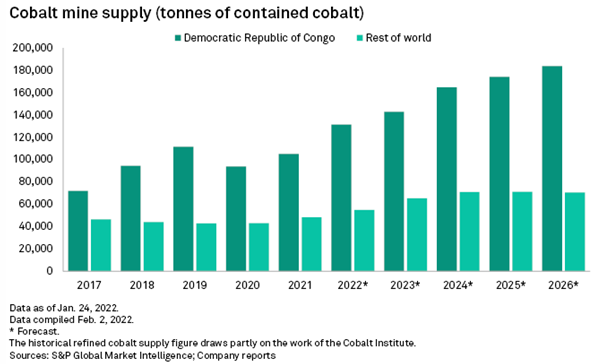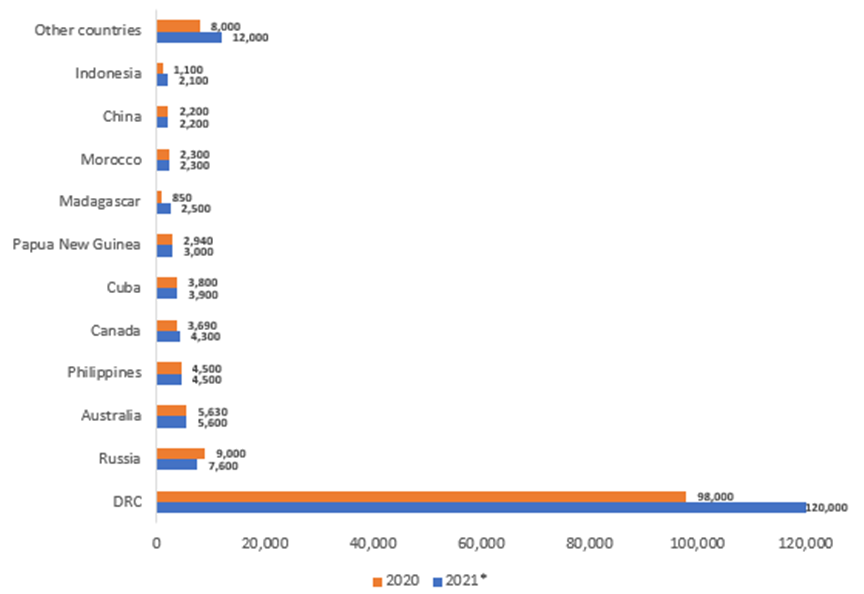“They think not there how much of blood it costs.” – Dante Alighieri, The Divine Comedy – Paradiso.
Cobalt is critical to the transition to a zero-emissions economy. With unique properties, cobalt is an essential component of the lithium-ion batteries that power electric vehicles and store energy from wind and solar. It is in our smartphones and laptops. But few people know the true cost of cobalt. People die for this mineral. Children suffer for it. Communities and natural environments are sacrificed for it. This article puts a spotlight on cobalt, its benefits, and its social costs.
Cobalt is an element with the symbol Co and the atomic number 27 – which tells us little about the importance of or controversy surrounding the blue metal. The name cobalt derives from the German Kobold for “evil spirits” or “goblins”, who were thought to cause trouble for miners because cobalt ores typically contained high levels of arsenic which impacted their health.
Cobalt is essential for living things. It is required for the proper functioning of enzymes and regulates the production of red blood cells. Cobalt is the central atom in vitamin B12 which is essential for all animal life.
Although not formally discovered and isolated until 1735 by Swedish chemist Georg Brandt, cobalt compounds were used by ancient civilisations to create blue tinted glass and ceramics. Cobalt has been detected in Persian jewellery from the third millennium BC and was common in ancient Roman glass and Tang dynasty Chinese porcelain.
Figure 1: Roman Blue Glass Pitcher 3rd Century AD

Source: Romisch-Germanisches Museum Cologne.
For most of its history, cobalt has been a relatively low value mineral. With the start of the industrial age its value increased as uses were found for the mineral. Cobalt is used in electroplating to give objects an attractive surface that resists oxidation. It is used to form ‘superalloys’ such as Alnico, an alloy of unusual magnetic strength consisting of aluminium, nickel, and cobalt, which is used to make powerful permanent magnets and electric motors. Stellite alloys, which contain cobalt, chromium, and tungsten, are used to make high-speed and high temperature cutting tools and dyes.
A dramatic change for cobalt came in the 1990s when the Sony Corporation first commercialised cobalt-based lithium-ion batteries. Lithium-ion batteries had been invented in 1980 by American physicist John Goodenough. Cobalt-based batteries were an improvement on previous battery types because they have higher specific energy versus weight and can hold charge and power over longer periods of time.
Figure 2: Sony Lithium-ion battery

The second dramatic change for cobalt came with the surge in electric vehicle (EV) production. Nickel-cobalt-manganese (NCM) and nickel-cobalt-aluminium (NCA) battery compositions have become dominant in the EV industry, accounting for over 90% of the global EV battery market in 2021.1
Cobalt ranks 33rd in the abundance of all metals in the earth’s crust. It is widely scattered, yet it appears in economic quantities in fewer than 20 countries globally. In 2021, 120,000 tonnes of cobalt were produced, with the Democratic Republic of the Congo (DRC) supplying over 70%.
Figure 3: Cobalt Production by Country
Source: US Geological Survey.
Figure 4: Historic and Forecast Cobalt Production

Artisan cobalt mining in the DRC
The DRC is not the most politically stable of countries. Following a US-backed coup in 1965 the country was renamed Zaire and led by dictator Colonel Joseph Mobuto, who held on to power until 1997 when Rwandan and Ugandan-backed rebel forces overran the capital and forced him into exile. This was followed by a period of near constant warfare and ongoing violence as foreign-backed militias and competing warlords vied for power and control of territory. Much of the violence had its origins in the 1994 genocide of ethnic Tutsi in neighbouring Rwanda.
In 2001 the new president, former rebel leader Laurent-Desire Kabila, was assassinated by his own bodyguard. His son Joseph Kabila ruled the DRC until 2018.
The current President of the DRC is Felix Tshisekedi. His election in January 2019 marked the first peaceful transition of power since 1960. The country however remains torn by violence, and it is estimated that as many as 6 million people have died since 1996. The UN currently has over 17,000 personnel involved in peacekeeping operations under the United Nations Stabilisation Mission in the DRC (MONUSCO).
Figure 5: UN Peacekeepers in the DRC

Source: United Nations Photo.
While most cobalt mined in the DRC comes from large mines operated by international companies like the giant Glencore Mutanda mine in Katanga province, up to 40% comes from small artisan mines, many controlled by local warlords and used to fund the ongoing conflict.
Figure 6: Luwowo Coltan mine North Kivu province

Source: MONUSCO/Sylvain Liechti.
Small-scale mining in the DRC is characterised by harsh conditions, forced labour and child labour. Of the 255,000 Congolese mining for cobalt, 40,000 are children under the age of 18, with some as young as six years old. Labourers typically earn less than $2 per day while using their own tools, primarily their hands.
In its 2017 report Time to Recharge, Amnesty International ranked major electronic and electric vehicle companies on their cobalt sourcing practices. It found that while some, like Apple and Samsung SDI, had made progress, others had failed to take even the most basic steps to improve their cobalt sourcing practices. In 2019 several companies were named in a lawsuit filed in the US on behalf of 14 Congolese families following the death of child miners buried alive or suffering severe injury following the collapse of tunnels.
Responsible cobalt initiative
While things remain grim, there are some signs of progress. Formed in 2016 with backing from the Chinese Chamber of Commerce for Metals, Minerals and Chemicals (CCCMC) and the Organisation for Economic Co-operation and Development (OECD), the Responsible Cobalt Initiative (RCI) was established to:
“…undertake collective action in addressing social and environmental risks in the cobalt supply chain. As a priority, the RCI intends to address the issues of the worst forms of child labour.”
Spearheaded by former Microsoft executive Christina Feng, the RCI in 2018 implemented a cobalt refiner assessment program. This established clear supply chain due diligence standards. More than 30 cobalt refiners now take part in the Responsible Minerals Assurance Process (RMAP) of the RMI and undergo an independent third-party supply chain audit. Initiatives that aim to integrate artisan mines into the RMAP include the Better Mining partnership’s data monitoring project, which aims to monitor 12 artisan and small mine sites in the DRC by 2023.
A 2020 report from the UN PRI on collaborative engagement by a total of 46 institutional investors found that only a handful of companies proactively assess the human rights impacts of their core business processes. While some progress has been made, it emphasised the importance of investors remaining committed to engaging on core issues and challenges associated with cobalt sourcing.
The index methodologies underlying BetaShares’ ethical suite of ETFs (ASX: ETHI, HETH, FAIR and GBND) apply extensive ethical screens, including a screen to exclude companies with evidence of human rights violations, such as child labour and modern slavery, in their operations and supply chains. At the May 2022 rebalance of ETHI’s index, a number of companies were excluded after applying the human rights violations screen including one company with cobalt smelting operations. In 2021-22, the index’s responsible investment committee engaged extensively on human rights issues including encouraging companies to improve transparency in their supply chains and to take additional steps to protect worker rights in the supply of minerals and rare earths.
|
BetaShares Capital Ltd (ABN 78 139 566 868 AFS Licence 341181) is the issuer of the BetaShares Funds. Read the Target Market Determination and PDS at www. betashares.com.au and consider with your financial adviser whether the Funds are appropriate for your circumstances. Investments in BetaShares Funds are subject to investment risk and the value of units may go down as well as up. |
1. Source: https://stratasadvisors.com/Insights/2021/07292021-EV-Cobalt-Assessment
This article mentions the following funds
Ex Suncorp, Russell Investments, QIC and Mercer. Past Director of the Investment Management Consultants Institute (IMCA) and Management Committee of the Investor Group on Climate Change (IGCC)
Read more from Greg.



